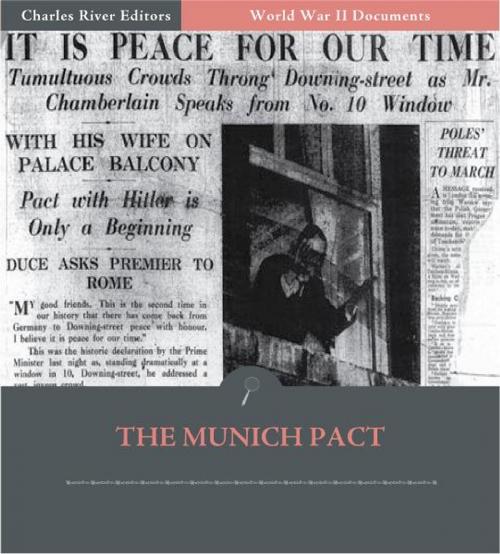World War II Documents: The Munich Pact (Illustrated Edition)
Nonfiction, History, World History, Military, United States, World War II| Author: | U.S. Government | ISBN: | 9781619828056 |
| Publisher: | Charles River Editors | Publication: | February 17, 2012 |
| Imprint: | Language: | English |
| Author: | U.S. Government |
| ISBN: | 9781619828056 |
| Publisher: | Charles River Editors |
| Publication: | February 17, 2012 |
| Imprint: | |
| Language: | English |
On September 30, 1938, British Prime Minister Neville Chamberlain returned to Britain and promised the British peace for our time in reference to the agreement signed the day before between him, Adolf Hitler, and Benito Mussolini in Munich. Of course, Neville Chamberlain and Munich would become synonymous with appeasement, a word that has since taken on very negative connotations, and war would explode across the continent exactly 11 months later. As the previous appeasement of Hitler had shown, the governments of both France and the United Kingdom were set on avoiding war at any cost. The French government did not wish to face Nazi Germany alone and took its lead from the British government and its Prime Minister Neville Chamberlain. Chamberlain believed that Sudeten German grievances were justified and that Hitler's intentions were limited. Both Britain and France, therefore, advised Czechoslovakia to concede to the Nazi demands. Beneš resisted and on May 20 a partial mobilization was underway in response to possible German invasion. Ten days later, Hitler signed a secret directive for war against Czechoslovakia to begin no later than October 1. The Munich deal on September 29 and signed early in the morning on September 30. Adolf Hitler, Neville Chamberlain, Benito Mussolini and Édouard Daladier signed the Munich Agreement. The agreement was officially introduced by Mussolini although in fact the so-called Italian plan had been prepared in the German Foreign Office. It was nearly identical to the Godesberg proposal: the German army was to complete the occupation of the Sudetenland by October 10, and an international commission would decide the future of other disputed areas. Of course, Hitler would ignore the terms of the agreement and quickly invade the rest of Czechoslovakia shortly after, proving the futility of the appeasement attempt. This edition of the historic Munich Pact is specially formatted with a Table of Contents and is illustrated with pictures of the wars important leaders, as well as pictures of the conference itself.
On September 30, 1938, British Prime Minister Neville Chamberlain returned to Britain and promised the British peace for our time in reference to the agreement signed the day before between him, Adolf Hitler, and Benito Mussolini in Munich. Of course, Neville Chamberlain and Munich would become synonymous with appeasement, a word that has since taken on very negative connotations, and war would explode across the continent exactly 11 months later. As the previous appeasement of Hitler had shown, the governments of both France and the United Kingdom were set on avoiding war at any cost. The French government did not wish to face Nazi Germany alone and took its lead from the British government and its Prime Minister Neville Chamberlain. Chamberlain believed that Sudeten German grievances were justified and that Hitler's intentions were limited. Both Britain and France, therefore, advised Czechoslovakia to concede to the Nazi demands. Beneš resisted and on May 20 a partial mobilization was underway in response to possible German invasion. Ten days later, Hitler signed a secret directive for war against Czechoslovakia to begin no later than October 1. The Munich deal on September 29 and signed early in the morning on September 30. Adolf Hitler, Neville Chamberlain, Benito Mussolini and Édouard Daladier signed the Munich Agreement. The agreement was officially introduced by Mussolini although in fact the so-called Italian plan had been prepared in the German Foreign Office. It was nearly identical to the Godesberg proposal: the German army was to complete the occupation of the Sudetenland by October 10, and an international commission would decide the future of other disputed areas. Of course, Hitler would ignore the terms of the agreement and quickly invade the rest of Czechoslovakia shortly after, proving the futility of the appeasement attempt. This edition of the historic Munich Pact is specially formatted with a Table of Contents and is illustrated with pictures of the wars important leaders, as well as pictures of the conference itself.















